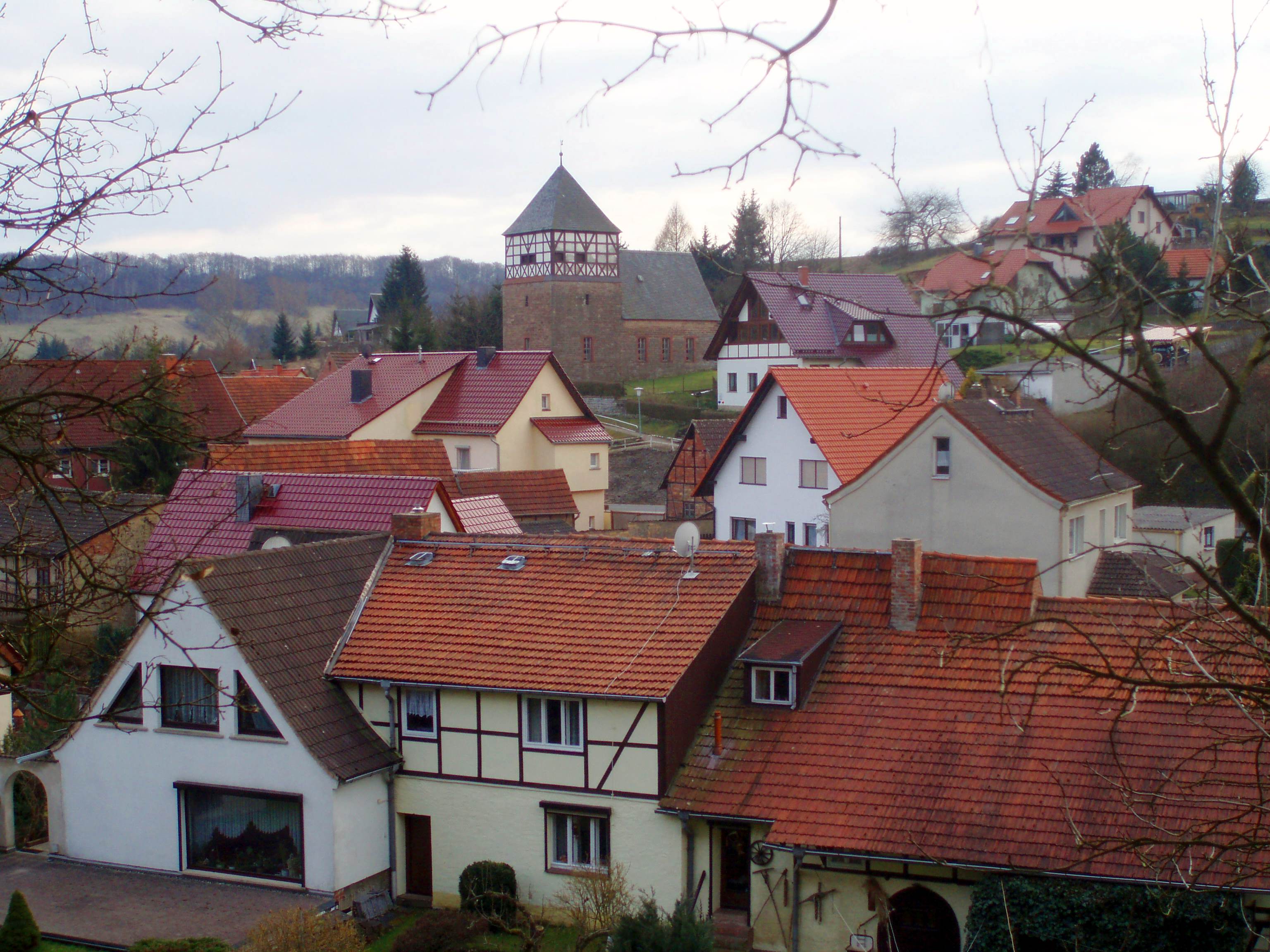|
Grillenberg (Sangerhausen)
Grillenberg is a village in the municipality of Sangerhausen in the German state of Saxony-Anhalt. Location The village is around 9 kilometres north of Sangerhausen on the edge of the Harz mountains. Since 27 November 2006 Grillenberg has borne the title "state-recognised resort" (''Staatlich anerkannter Erholungsort''). History Grillenberg was probably first recorded in the register of the tithes of Hersfeld Abbey Hersfeld Abbey was an important Benedictine imperial abbey in the town of Bad Hersfeld in Hesse (formerly in Hesse-Nassau), Germany, at the confluence of the rivers Geisa, Haune and Fulda. The ruins are now a medieval festival venue. History ... dating to between 881 and 899, as the tithe-owing village of 'Coriledorpf'. In 1147 the Grilleberg Castle estate (''Burgamt Grillenberg'') appears as part of the old Barony of Sangerhausen. The estate was detached and given to the Thuringian count, Lambertius (of Gleichen), who called himself ''comes de Monte'' ("co ... [...More Info...] [...Related Items...] OR: [Wikipedia] [Google] [Baidu] |
Sangerhausen
Sangerhausen () is a town in Saxony-Anhalt, central Germany, capital of the district of Mansfeld-Südharz. It is situated southeast of the Harz, approx. east of Nordhausen, and west of Halle (Saale). About 26,000 people live in Sangerhausen (2020). History Sangerhausen is one of the oldest towns in the historical region of Saxony-Anhalt, being first mentioned in a document created between 780 and 802 in Fulda Abbey. Sangerhausen is mentioned as the tithable place ''Sangerhus'' in Friesenfeld in the Hersfeld Tithe Register, created between 881 and 899. It is mentioned in a document of 991 as appertaining to the estates of the emperor, as part of Memleben Abbey. By marriage it passed to the landgrave of Thuringia, and after 1056 it formed for a while an independent country. Having been again part of Thuringia, it fell in 1249 to Meissen, and in 1291 to Brandenburg. In 1372 it passed to the Electorate of Saxony and formed a portion of that territory until 1815, when it became ... [...More Info...] [...Related Items...] OR: [Wikipedia] [Google] [Baidu] |
Saxony-Anhalt
Saxony-Anhalt (german: Sachsen-Anhalt ; nds, Sassen-Anholt) is a state of Germany, bordering the states of Brandenburg, Saxony, Thuringia and Lower Saxony. It covers an area of and has a population of 2.18 million inhabitants, making it the 8th-largest state in Germany by area and the 11th-largest by population. Its capital is Magdeburg and its largest city is Halle (Saale). The state of Saxony-Anhalt was formed in July 1945 after World War II, when the Soviet army administration in Allied-occupied Germany formed it from the former Prussian Province of Saxony and the Free State of Anhalt. Saxony-Anhalt became part of the German Democratic Republic in 1949, but was dissolved in 1952 during administrative reforms and its territory divided into the districts of Halle and Magdeburg. Following German reunification the state of Saxony-Anhalt was re-established in 1990 and became one of the new states of the Federal Republic of Germany. Saxony-Anhalt is renowned for its ri ... [...More Info...] [...Related Items...] OR: [Wikipedia] [Google] [Baidu] |
Harz Mountains
The Harz () is a highland area in northern Germany. It has the highest elevations for that region, and its rugged terrain extends across parts of Lower Saxony, Saxony-Anhalt, and Thuringia. The name ''Harz'' derives from the Middle High German word ''Hardt'' or ''Hart'' (hill forest). The name ''Hercynia'' derives from a Celtic name and could refer to other mountain forests, but has also been applied to the geology of the Harz. The Brocken is the highest summit in the Harz with an elevation of above sea level. The Wurmberg () is the highest peak located entirely within the state of Lower Saxony. Geography Location and extent The Harz has a length of , stretching from the town of Seesen in the northwest to Eisleben in the east, and a width of . It occupies an area of , and is divided into the Upper Harz (''Oberharz'') in the northwest, which is up to 800 m high, apart from the 1,100 m high Brocken massif, and the Lower Harz (''Unterharz'') in the east which is up to aroun ... [...More Info...] [...Related Items...] OR: [Wikipedia] [Google] [Baidu] |
Kirche Grillenberg
Kirk is a Scottish and former Northern English word meaning "church". It is often used specifically of the Church of Scotland. Many place names and personal names are also derived from it. Basic meaning and etymology As a common noun, ''kirk'' (meaning 'church') is found in Scots, Scottish English, Ulster-Scots and some English dialects, attested as a noun from the 14th century onwards, but as an element in placenames much earlier. Both words, ''kirk'' and ''church'', derive from the Koine Greek κυριακόν (δωμα) (kyriakon (dōma)) meaning ''Lord's (house)'', which was borrowed into the Germanic languages in late antiquity, possibly in the course of the Gothic missions. (Only a connection with the idiosyncrasies of Gothic explains how a Greek neuter noun became a Germanic feminine). Whereas ''church'' displays Old English palatalisation, ''kirk'' is a loanword from Old Norse and thus retains the original mainland Germanic consonants. Compare cognates: Icelandic & ... [...More Info...] [...Related Items...] OR: [Wikipedia] [Google] [Baidu] |
Hersfeld Abbey
Hersfeld Abbey was an important Benedictine imperial abbey in the town of Bad Hersfeld in Hesse (formerly in Hesse-Nassau), Germany, at the confluence of the rivers Geisa, Haune and Fulda. The ruins are now a medieval festival venue. History Hersfeld was founded by Saint Sturm, a disciple of Saint Boniface, before 744. Because its location rendered it vulnerable to attacks from the Saxons, however, he transferred it to Fulda. Some years later, in or about 769 after the defeat of the Saxons by the Franks, Lullus, archbishop of Mainz, re-founded the monastery at Hersfeld. Charlemagne (who had recently succeeded to the Frankish royal crown) and other benefactors provided endowments, and in 775 gave it the status of a ''Reichsabtei'' "imperial abbey" (i.e., territorially independent prince-abbacy within the Empire). Pope Stephen III granted it exemption from episcopal jurisdiction. It soon possessed 1050 hides of land and a community of 150 monks. Lullus was buried in the chu ... [...More Info...] [...Related Items...] OR: [Wikipedia] [Google] [Baidu] |
Saint Nicholas
Saint Nicholas of Myra, ; la, Sanctus Nicolaus (traditionally 15 March 270 – 6 December 343), also known as Nicholas of Bari, was an early Christian bishop of Greeks, Greek descent from the maritime city of Myra in Asia Minor (; modern-day Demre, Turkey) during the time of the Roman Empire. Because of the many miracles attributed to his intercession, he is also known as Nicholas the Wonderworker. Saint Nicholas is the patron saint of sailors, merchants, archers, repentant thieves, children, brewers, pawnbrokers, unmarried people, and students in various cities and countries around Europe. His reputation evolved among the pious, as was common for early Christian saints, and his legendary habit of secret gift-giving gave rise to the traditional model of Santa Claus ("Saint Nick") through Sinterklaas. Little is known about the historical Saint Nicholas. The earliest accounts of his life were written centuries after his death and probably contain legendary elaborations. He is ... [...More Info...] [...Related Items...] OR: [Wikipedia] [Google] [Baidu] |
Statistisches Bundesamt
The Federal Statistical Office (german: Statistisches Bundesamt, shortened ''Destatis'') is a federal authority of Germany. It reports to the Federal Ministry of the Interior. The Office is responsible for collecting, processing, presenting and analysing statistical information concerning the topics economy, society and environment. The purpose is providing objective, independent and highly qualitative statistical information for the whole public. About 2300 staff members are employed in the departments in Wiesbaden, Bonn and Berlin. The department in Wiesbaden is the main office and runs the largest library specialised in statistical literature in Germany. It is also the Office of the President who is also by tradition, but not by virtue of the office, the Federal Returning Officer. In this position, they are the supervisor of the elections of the German Parliament ("Bundestag") and of the European Parliament. The Berlin Information Point is the service centre of the Federal O ... [...More Info...] [...Related Items...] OR: [Wikipedia] [Google] [Baidu] |
Former Municipalities In Saxony-Anhalt
A former is an object, such as a template, gauge or cutting die, which is used to form something such as a boat's hull. Typically, a former gives shape to a structure that may have complex curvature. A former may become an integral part of the finished structure, as in an aircraft fuselage, or it may be removable, being using in the construction process and then discarded or re-used. Aircraft formers Formers are used in the construction of aircraft fuselage, of which a typical fuselage has a series from the nose to the empennage, typically perpendicular to the longitudinal axis of the aircraft. The primary purpose of formers is to establish the shape of the fuselage and reduce the column length of stringers to prevent instability. Formers are typically attached to longerons, which support the skin of the aircraft. The "former-and-longeron" technique (also called stations and stringers) was adopted from boat construction, and was typical of light aircraft built until the ... [...More Info...] [...Related Items...] OR: [Wikipedia] [Google] [Baidu] |







